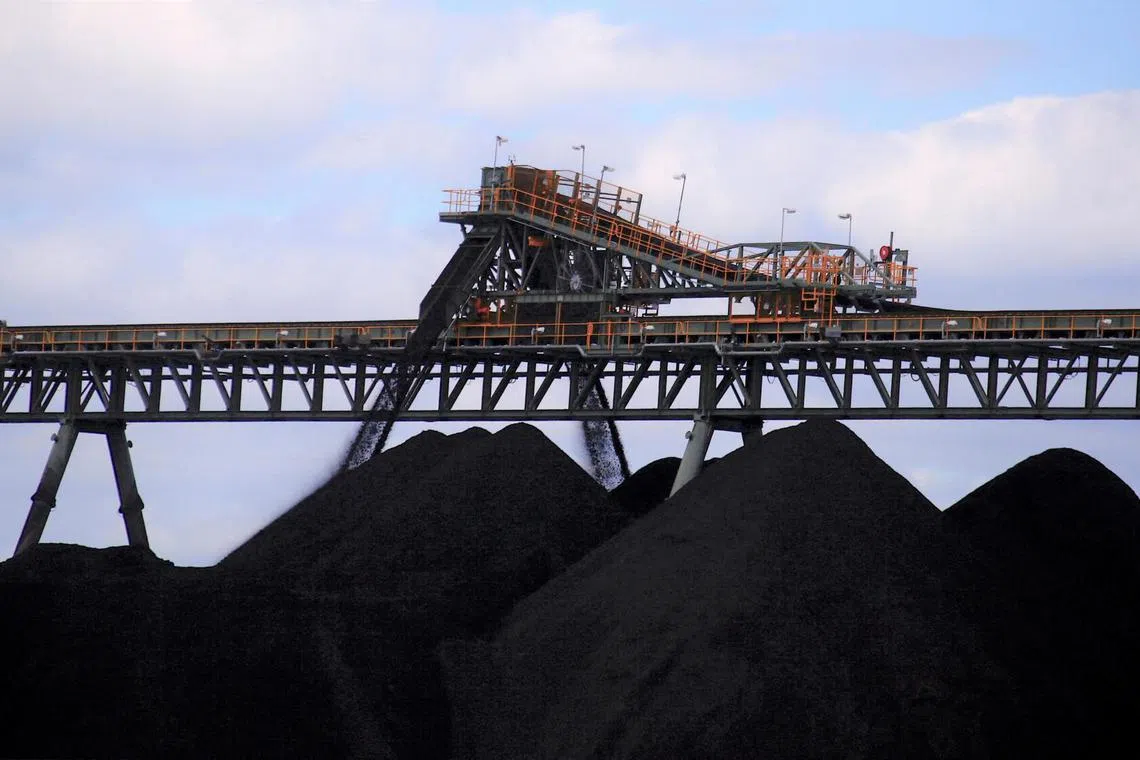Australia edges closer to big emissions reduction Bill with hit to gas investments
Sign up now: Get insights on Asia's fast-moving developments

Piles of coal near a coal mine in New South Wales state. While Australian Prime Minister Anthony Albanese has tightened national emissions targets, his administration has also faced criticism over its support for some coal and gas developments.
PHOTO: REUTERS
Follow topic:
CANBERRA – Australia’s Lower House of Parliament on Monday passed an emissions reduction plan with curbs on some new gas and coal investments and a cap on total greenhouse gas emissions from the country’s biggest polluters after a key deal with the Greens party.
The “Safeguard Mechanism” reform legislation is key to the Labor government’s pledge to cut emissions by 43 per cent by 2030 one of the world’s biggest carbon emitters per capita.
Weeks of talks with the Greens, whose support is needed in the Upper House Senate, yielded changes such as a hard total emissions cap, ministerial review for projects that raise total emissions and compulsory disclosures for polluters that rely heavily on carbon offsets to meet their targets.
The updated legislation also requires all new gas projects in the Beetaloo Basin – a gas- and oil-rich area about 500km south-east of Darwin – to have net-zero carbon emissions, and new gas fields supplying existing liquefied natural gas plants to have net-zero reservoir emissions, imposing new costs.
“Today, we are a step closer to achieving net zero by 2050,” Energy Minister Chris Bowen said.
Support from the Greens, which originally wanted to ban all new fossil fuel projects, leaves the government short of two votes in the Senate, where it is wooing independents.
The plan, due to take effect on July 1, aims to make about 215 oil, gas, mining and manufacturing facilities that annually emit more than 100,000 tonnes of carbon dioxide-equivalent cut their emissions by 30 per cent over the next seven years.
Under the revised law, projects such as the massive Browse field in Western Australia that Woodside Energy wants to develop would have to have carbon capture and storage to achieve the net-zero goal.
Shares in Woodside fell 2.3 per cent, while Tamboran Resources, which is looking to develop a project in the Beetaloo Basin, fell 6.7 per cent in a broader market that was up 0.2 per cent.
The government said it would tip in A$400 million (S$354 million) to help the cement, steel and aluminium industries decarbonise.
Under the mechanism, the country’s top emitting facilities would have to cut greenhouse gas emissions by 4.9 per cent a year by 2030, and it will now also restrict the use of carbon offsets, the Greens said on Monday.
“Coal and gas pollution was set to soar under Labor’s safeguard,” Australian Greens leader Adam Bandt said in a statement. “The Greens have introduced a hard cap on emissions, meaning real pollution must actually come down and the coal and gas corporations can’t buy their way out of the cap with offsets.”
Australia’s Labor government came to power in May 2022 with a vow to reverse the nation’s reputation as a climate laggard.
An immediate ban on future gas projects would be “irresponsible”, Mr Bowen said recently, adding that the fuel will be necessary to complement a transition to the government’s target of 82 per cent renewable generation by 2030.
The main opposition centre-right coalition of the Liberals and Nationals in February said it would vote against the proposed legislation.
The deal won cautious support from campaign groups.
Greenpeace Australia Pacific head of advocacy and strategy Glenn Walker said the most important task at hand for Parliament is to rule out new fossil fuel mines in favour of clean, future-proof industries.
“After a decade of inaction, we welcome this progress on emissions reduction from the Australian Parliament. It is true that this deal does not go as far as the science requires, but continued policy paralysis was unpalatable and momentum is essential,” he said in a statement.
“While the improvements in the deal make the Safeguard Mechanism policy stronger, there will be a need for ongoing changes to close up remaining loopholes. In particular, despite some changes to how carbon offsets will be used, we remain concerned about coal and gas companies simply buying up carbon offsets rather than reducing emissions.”
Australia’s Climate Council said the significantly strengthened mechanism will drive down emissions and make it more difficult for new coal and gas projects to be approved.
“This will be the federal Parliament’s first reform to genuinely cut pollution in a decade,” said Climate Council chief executive Amanda McKenzie in a statement.
“Almost one year ago, Australians sent a clear message at the polls that they wanted our Parliament to act on climate change. Today, they are getting on with it. This will mean more clean, renewable power, and less pollution. Finally, as a nation, Australia is starting to tackle the climate crisis.” REUTERS, BLOOMBERG

